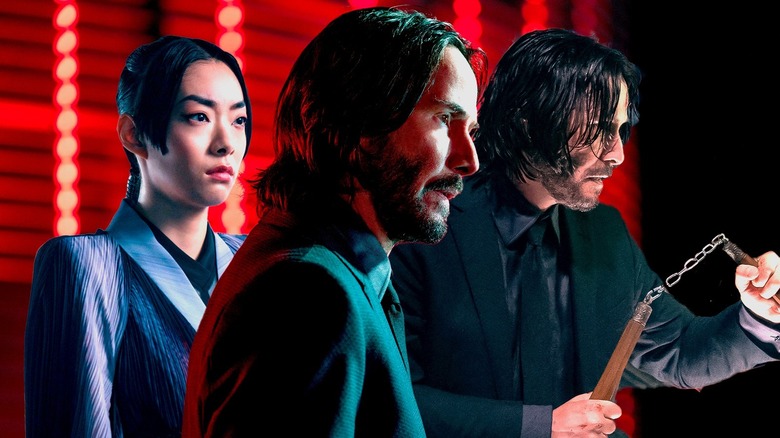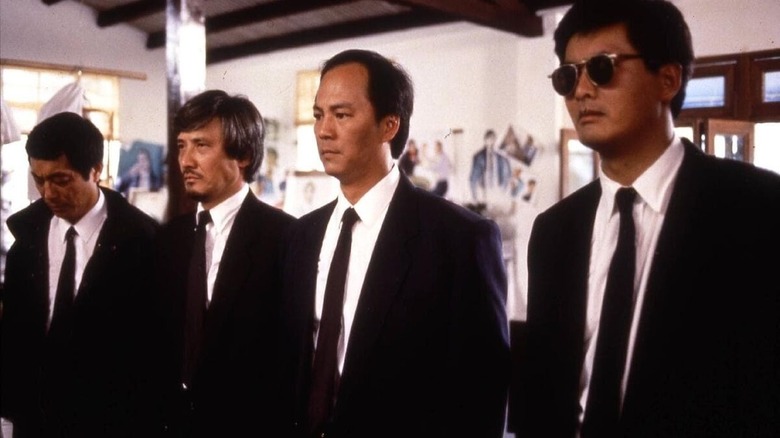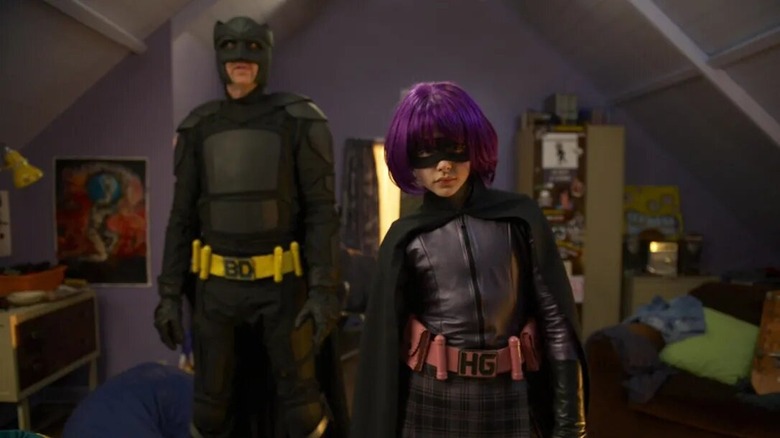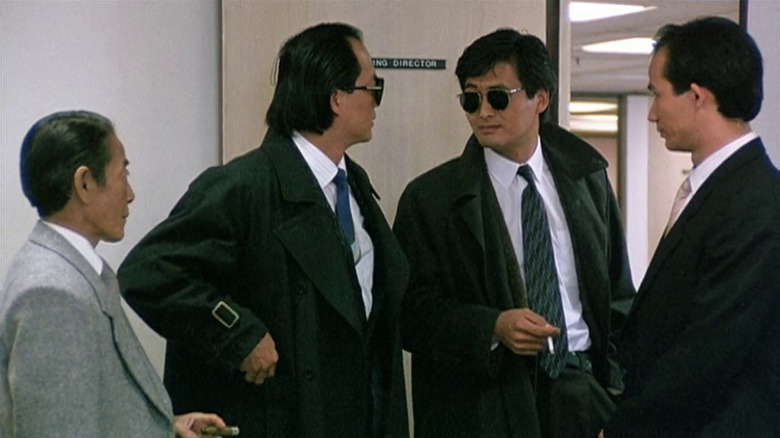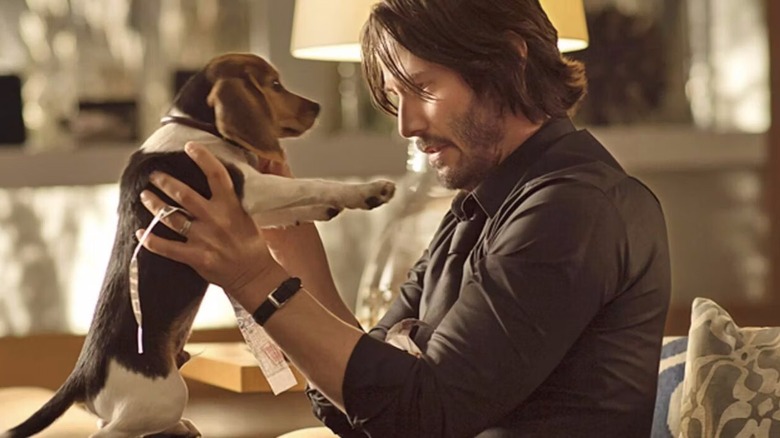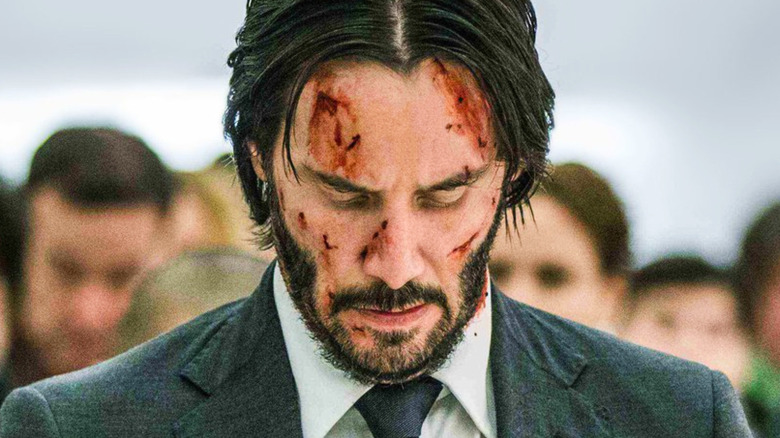John Wick Proves That There's An Appetite For Hong Kong-Style Gun Fu - And Hollywood Needs To Feed It
It's a good time for action movies. The Marvel Cinematic Universe is catering to the demand for superhero blockbusters, and DC is trying its best to keep up. Tom Cruise is fighting to keep death-defying stunt work alive while proving that age is a state of mind, having become Hollywood's last great action star. The "Fast and Furious" franchise provides high-octane nonsense that's anchored by down-to-earth family values. And Gerard Butler is carrying the torch for your dad's favorite action movies. But the "John Wick" saga is where it's at for the action buffs who appreciate hitman lore, inventive combat sequences, and Keanu Reeves rocking fancy suits.
The "John Wick" franchise — which tells the story of a dog-loving hitman (Reeves) as he blasts through the entire criminal underworld — is an outlier in the current Hollywood landscape. In addition to being more violent than typical action blockbusters, the films are spiritual successors to the Hong Kong gun-fu and Heroic Bloodshed movies that directors such as John Woo and Ringo Lam unleashed in the '80s and early '90s. Sure, "John Wick" was inspired by lots of cool things — Sergio Leone Westerns, Greek mythology, Buster Keaton, etc. — but the influence of Hong Kong bullet ballets is a constant presence throughout.
"John Wick: Chapter 4" is on the way, and spin-offs like "The Continental" and "Ballerina" will follow at some point. However, it's sad that more Hollywood movies haven't embraced hard-hitting gun-fu stories. This saga's success proves that there's a Western audience for this subgenre, and it deserves to be fed beyond the world of Chad Stahelski and Derek Kolstad's hitman franchise.
With A Better Tomorrow, John Woo gave birth to gun fu
"Gun fu" is a term used to describe an action movie style that mixes kung fu with guns, and John Woo's 1986 masterpiece "A Better Tomorrow" is the movie that started it all. The film follows an ex-Triad member (Ti Lung) as he tries to reconnect with his estranged policeman brother, but the former gangster can't escape his old life. It's a storyline that we've seen countless times, but the action sequences in "A Better Tomorrow" changed the game forever.
The gunfights in Woo's classic have more in common with Chinese wuxia and martial arts films than they do with standard gun-centric action movies. Firearms are used like swords — unsheathed from their holsters and swung around in constant motion until everyone is dead. There's more to gun-fu shootouts than pulling triggers — they're all about grace, style, and adding some extra oomph to the action.
Similarly, "A Better Tomorrow" apes kung-fu movies in the sense that every bullet is meant to be felt, just like a punch, kick, or palm to the chest. Blood gushes out of people's bodies when the bullets pierce their skin, and the camera continues to follow the poor souls as they go crashing through walls and down stairwells. The shootouts are stylish, balletic, and grueling, and they're among the best in the history of action cinema. Before Woo's films, shootouts tended to be one-and-done affairs, but gun fu made them more ferocious and impactful.
Woo went on to perfect this brand of stylized gun-toting action in movies like "The Killer" and "Hard Boiled," and it was only a matter of time until Hollywood took notice.
Hollywood flirted with gun fu prior to John Wick
Whenever movies from overseas make some noise, the American film industry takes notice and tries to copy them. This is evidenced by the countless Hollywood remakes of excellent international movies, but it also extends to trends such as the New French Extremity and gun fu. After John Woo conquered Hong Kong cinema, he was hired by American studios to helm movies like "Hard Target" and "Face/Off," and he brought some of that signature style with him.
"Face/Off" is the crème de la crème of Woo's American movies. His trademark gun-fu violence is present and accounted for, especially during the penthouse and airport shootouts, which are nonstop barrages of poetic bullet-induced mayhem. John Travolta and Nicolas Cage aren't as elegant with firearms as Hong Kong genre veterans such as Ti Lung or Chow Yun-fat, but "Face/Off" is still a noble attempt at incorporating Woo's brand of action into a Hollywood blockbuster.
That said, gun-fu movies in Hollywood are few and far between, even though some of them have been very popular. "The Matrix" contains some impressive gun-fu sequences, and the genre's DNA can be found in some of Quentin Tarantino and Robert Rodriguez's best efforts. Matthew Vaughn's "Kick-Ass" and "Kingsman: The Secret Service" boast some impressive gun-fu scenes as well, most notably during the latter's infamous church massacre.
And then there are the forgotten gems. "Equilibrium" is one of the most innovative gun-fu movies to come out of Hollywood, and it features an original firearms-based martial art known as "gun kata." All in all, though, Hollywood gun-fu movies rarely capture the emotional qualities that make the best Hong Kong action flicks so immortal.
There's more to gun fu than guns and kung fu
"Gun fu" is often used as a shorthand term to describe movies that blend gunplay and martial arts. However, the most notable Hong Kong efforts are known for their ability to seamlessly blend stylized carnage with sentimental melodrama and heightened emotion. In the 1980s, "Eastern Heroes" magazine editor Rick Baker coined "Heroic Bloodshed" as a catch-all term for movies of this ilk, and it's become a genre unto itself.
While some Heroic Bloodshed movies were bona fide game changers, the genre is an amalgamation of established cinematic conventions and concepts. The morally gray protagonists and their existential woes are lifted straight from hard-boiled noir. Gangsters and hitmen follow a strict code of honor that's similar to that of the moralistic outlaws in spaghetti Westerns and the wandering samurai in Akira Kurosawa flicks.
Additionally, the stories often take place in the neo-noir-flavored criminal underworlds that filmmakers such as Jean Paul-Melville were so fond of back in the day. A prime example is Ringo Lam's influential thriller "City on Fire," which follows an undercover cop who ends up sympathizing with the criminals he's supposed to take down. It's a tale that digs into the weeds of Hong Kong's underbelly, which is depicted as a chaotic and violent place. "John Wick" is in love with similar concepts, and the franchise boasts lots of the hallmarks that define Heroic Bloodshed.
John Wick is pure Heroic Bloodshed
The "John Wick" saga is a love letter to the John Woo and Ringo Lam schools of thought. Hollywood action movies are often guilty of hiding the action through quick cuts, CGI, and shaky cam techniques. However, this glorious franchise presents the good stuff through long takes that immerse the viewer in the fight scenes. They're also stylish, balletic, and extremely brutal.
"John Wick" is a beautiful marriage of gunplay and martial arts, combing jiu-jitsu, judo, and tactical gun work to great effect. This style is showcased throughout the series, but the museum scene in "John Wick: Chapter 2" is a real standout example of gun fu at its best. Here, Keanu Reeves' titular assassin traps his enemies in armbars before blowing their brains to smithereens. He even throws his gun at people's faces like it's a blade, once again highlighting gun fu's relationship with traditional wuxia cinema.
The "John Wick" franchise is a true Hollywood successor to the golden age of Heroic Bloodshed movies. Reeves' angel of death is a lone-wolf gunslinger, trapped in a seedy criminal underworld that keeps pulling him back in. There's a healthy dose of mushy melodrama, as Wick's murderous rampage stems from some scumbags killing his adorable dog, which just so happened to be a gift from his dead wife. Furthermore, the hitman underworld has rules and systems that most of its denizens adhere to, so there's some honor among the thieves.
The end of John Wick will be a sad day in Hollywood
Hollywood deserves credit for green-lighting "John Wick" in the first place. It's an original action franchise that built itself from the ground up, marching to the beat of its own drum along the way. There aren't many R-rated blockbusters coming out that wear their gun-fu and Heroic Bloodshed influences on their sleeves — especially ones that aren't based on comic books. Unfortunately, the "John Wick" franchise won't be around forever, and when it does go away, the cinematic landscape won't be the same.
Of course, there are some filmmakers who are fighting to bring hard-hitting actioners into the international spotlight. Gareth Evans, the maestro behind the "Raid" movies, is currently working on "Havoc," a Heroic Bloodshed-inspired action thriller starring Tom Hardy as a detective who must fight his way through the criminal underworld. Evans is arguably the best action director working today, and he's a student of the kinetic, hard-boiled cinema from the Eastern corners of the globe.
At the same time, Hollywood could benefit from letting Asian filmmakers tell action-packed Heroic Bloodshed stories on the screen. Indonesia's Timo Tjahjanto is a keen practitioner of the style, and 2018's "The Night Comes for Us" is a bona fide "hold my beer" moment for action cinema. It's time for major Hollywood studios to gamble on more international action mavericks like Tjahjanto and let them cut loose. Tom Cruise and superheroes are great and all, but Heroic Bloodshed offers a different type of thrill.
